o Does a power attenuator sound any good?
A power attenuator reduces dynamic depth to some degree. There is some debate about how significantly an attenuator flattens the dynamic depth. Guitar speakers sound best when pushed hard. Below about 1 watt, guitar speakers sound especially thin and fizzy.
o What speaker do I use, if any?
You use a conventional cab, putting the attenuator between the amp's output transformer (the amp's Spk Out jack) and the cab. If the amp has no such jack but only clips to a built-in speaker, have an amp tech install an inline 1/4" plug and jack.
If you drive 280 watts worth of speakers with 60 mW, it will sound thin and fizzy. This is not the fault of the power attenuator; the speakers aren't designed to respond correctly with such low wattage. Try reducing your cab wattage capacity when attenuating down to the milliwatt (TV) level.
You need to match the impedance of the amp, attenuator, and cab. The dummy load in the attenuator case has a certain impedance. You can sometimes push a 16 ohm attenuator and 16 ohm cab with an 8 ohm amp ouput setting, but check your manuals or check with the power attenuator manufacturer before doing so.
o Will a power attenuator hurt my amp?
It is not uncommon for use of a power attenuator to result in a blown output transformer or power tubes. These breakdowns might be caused by using a resistive load, but blown OTs have also been reported when using the reactive Marshall Power Brake with a Marshall head (and Marshall has been known to replace such OTs under warranty). The ability to push the amp so hard yet quietly encourages pushing the amp past its natural limit, in which case the amp would have blown up anyway even when driving an actual cab at that level of output-stage saturation.
o What are some specific products?
Specific power attenuator products, and amps with built-in power attenuation, are described at Amptone.com.
As with any equipment, different attenuators sound different. Listen to several combinations of attenuator, cab, and head, to decide which attenuator types and models you like best.
o All this gear is too expensive, and I want more control of the circuit. Can I make my own attenuator?
You can make your own power attenuator; in fact this is one of the most useful, easy, and inexpensive DIY projects. (Find "DIY" at Amptone.com home page.) Be careful to provide safe heat dissipation; don't melt your amp's covering.
o My 50 watt amp is too loud for at home. Shouldn't I just get a small, quiet 15 watt amp, to cut the volume level down to a third?
You should understand the logarithmic relation between wattage and perceived volume. See http://www.amptone.com/g112.htm - 5-watt tube amps are still as loud as a trumpet, 50 mW is needed for 1/8 the volume of 50 W. For private SPL in a typical restrictive apartment late at night, 15 saturated watts is far too loud for private playing.
o What does a power attenuator look like?
Power attenuators are packaged in several formats: rackmount, amp-top, built into the head. They are often packaged with two closely related circuits or features: a cabinet simulation filter, and a full dummy-load ability. Power attenuators usually have prominent heat-dissipation components such as heat sink, vented case, or fan.
o How does a power attenuator work, inside? What component type can be used to soak the excess power?
A power attenuator can be thought of as two components: a dummy load and a variable wattage-splitter control. This is clearest with the Kolbe The Attenuator and the Kolbe Silent Speaker. The Silent Speaker is the dummy load (and line-level tap), and The Attenuator is the variable wattage-splitter control. You can use a muffled cab as the dummy load instead of a built-in resistive or reactive load, but the monitor cab will still suffer some loss of Tone as it is pushed less.
There are several categories of power attenuator:
Some power attenuators only have a couple of steps, such as half and quarter power. Others have many incremental steps, and some alternative approaches have a continuous pot. So far, no power attenuator is MIDI-controlled, but that would enable switching from a loud clean power-amp sound to a quiet, saturated power- amp sound.
o How does a power attenuator produce more of a cranked sound than playing quietly?
A power attenuator setting does not cause output-stage saturation or change the amount of output-tube saturation; it enables output-stage saturation at quiet SPL in the room. There are three kinds of volume controls when using a power attenuator in a standard setup. The first ("gain") controls the amount of preamp distortion. The second ("master volume") controls the amount of power-tube saturation and output transformer distortion. The third ("attenuation") controls the amount of power sent through to the speakers, as opposed to being sent to the dummy load; this controls speaker distortion and room volume level.
o Are there alternative or complementary approaches for varying the SPL without changing the Tone?
Related approaches for getting power-tube saturation at variable SPL:
Products in these categories are documented at Amptone.com.
______________________
Is any other information needed for a FAQ? That would help a lot.
- [copy the existing product pictures from other pages to here]
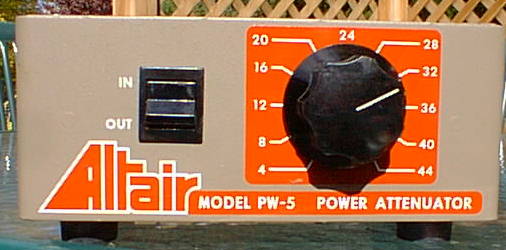
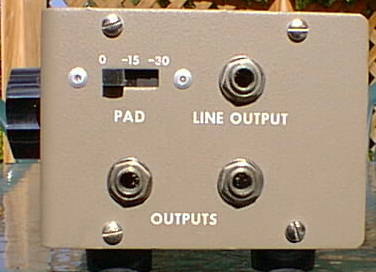
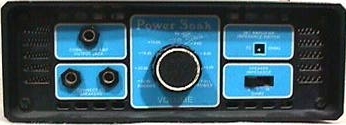
The following picture is by Steve -- see Steve's excellent site.
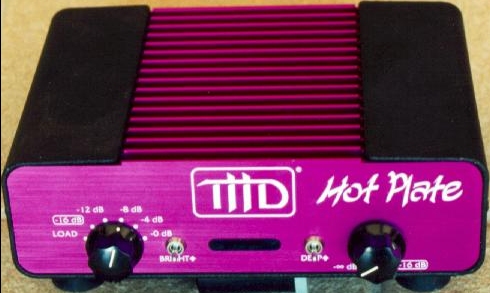
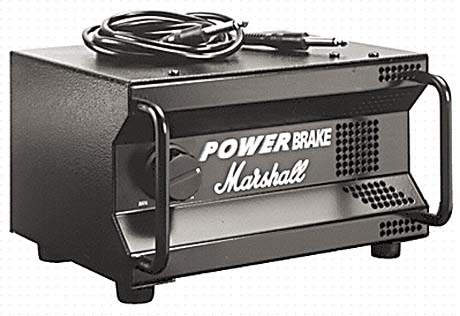
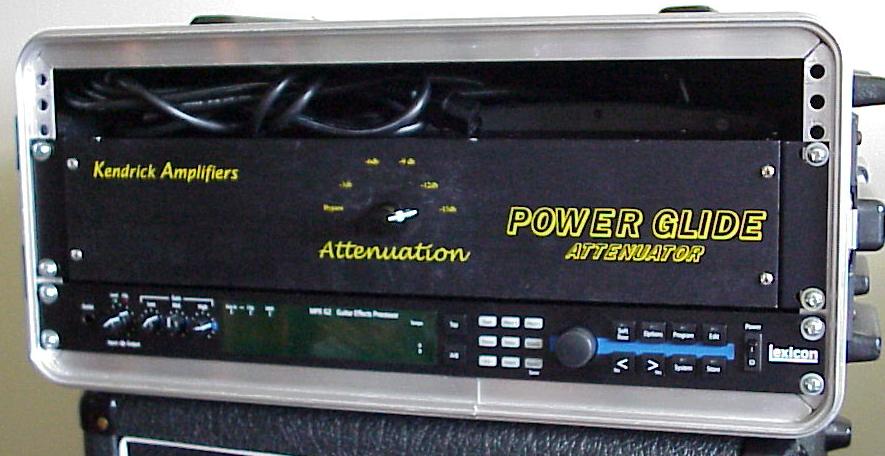
Photo provided to Amptone.com by Sean Moran.
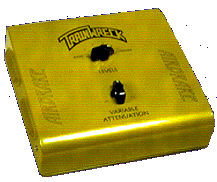
custom-sounds.com/tonetalk - You can also turn your master volume amp to power-amp distortion by turning the master-volume knob to 10 (or almost) and adjusting the pre-amp volume to your taste. You will find there are much more balls and dynamics with that kind of setting. The problem is that for that kind of tone you need to play the amp at full volume and with a 100W Plexi Marshall that is LOUD. You need to buy an amp that is loud enough for your use, or use one of the power attenuators that is available. Power attenuator is placed between amp and speaker and turns some (or all) of the amps output to heat and then reducing the volume of the amp at full power. You will get almost the same tone as when playing the amp at full volume only not that loud. I said almost because there is one factor that the attenuator can�t simulate very well; speaker distortion. All amps don�t have the speakers distortion, if you play with 50w Plexi Marshall to 2 modern 4 x12" cabinets that can handle about 700w, there is not going to be any speaker distortion. But with most combos with open back you get power that makes the speakers distort and same when playing 100w Plexi to a single vintage 4x12" cabinet with four 25w or 30w speakers. Not everyone like the speaker distortion and you and your audience (plus the club owner) are all very happy with one of these power attenuators. There is LB120 from KOCH, HOT PLATE from THD and Powerbrake from Marshall. Try what is best for your use and read what others have said about those from Harmony Central.
Guitarage: Power Soaks - Amplifiers: Using Power Soaks - "Why would I want to soak up power on my amplifier? I want all the power to go to the speaker". Yes in most cases this is what you want to do. However if you are practising and you're main equipment is a Marshall Stack, then I'm sure the neighbours wouldn't like to hear your Marshall Cranked all the way to 11. A power soak is used for just that, to soak up the power. However because the amplifier is working harder, if you're using a tube amplifier, be prepared to fork out for new tubes a lot more often. By soaking up the power that would normally go to the speaker, firstly it reduces the volume of the amplifier. Because the amp is being driven harder, you can crank the amplifier up to make the output tubes distort. Output valve distortion sounds a lot better than pre-amp tube distortion.
To connect a power soak up, you simply connect it between the output of the amplifier and your speakers. Most power soak devices have 4 terminals, however if they don't, simply disconnect the active output of the amplifier from the speaker and connect it to the power soak. Then run the output of the power soak to the speaker terminal that you disconnected the amplifier output from.
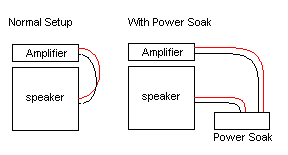 [from article]
[from article]
Sonny Landreth interview - "It looked like you were running through a power soak of some sort. What are you using?" "The Air Brake? Ken Fisher of Trainwreck actually designed it. Essentially it's a power attenuator that allows you get the sound of the amp when it's cranked, but maintain an appropriate speaker volume. Since it's in between the amp and the speakers, you can turn the speaker volume down. - Pretty handy for those smaller shows.. - Exactly, especially on stage at the Cain's Ballroom. That stage is LIVE. That folded section behind the drum riser acts like a huge horn."
classic-amps.com - nice article on distortion - "... the only two attenuators that I would trust are The THD Hot Plate, and The Trainwreck Air Brake. I've seen problems with The Marshall Power Brakes and The Scholtz Power Soak. Both of these units cause tubes to red plated after about ten minutes of use. There is no compensation for the loss of high frequency as the volume is cranked down. The loss of highs is noticeable after about 9-12db. I would caution anyone using attenuators to very closely monitor there power tubes for red plating, as once this starts it can lead to catastrophic failure up to and including blown output transformers."
Greg Howe interview - "The other setup is the modified Fender Dual Showman head, which I've been using since the "Introspection" album. I have 6 or 7 of these, and I'm still a little more comfortable with these amps, but they break down alot, which is why I'm reluctant to take them on the road with me. You have to run these amps real hard in order for them to sound good. I always use a power soak with the Dual Showmans because you really have to turn these things up very load to get the power section to open up. I don't like the way most stock amps sound because there's always too much gain built into the preamp stage."
Matchless amp manual - "POWER SOAK DEVICES: The use of "power-soak" devices is not recommended on your amplifier These devices can severely shorten the life of the output tubes which should be replaced as a matched quartet. Replacing vacuum tubes can be quite expensive. If however one of these devices is an integral part of your sound, choose one that is well designed and built by a reputable company. When the amplifier starts to sound dull, it's time to replace the output tubes. Always replace tubes with premium quality tubes only. Cheap tubes will not sound good and will not last. MATCHLESS sells replacement tubes for all models. Please contact your dealer or call the factory."
Enforcer Speaker Attenuator (By Inward Connections)
mention of Natec power attenuator
Enforcer attenuator for ham radio
xxx - "If you are using a tube power amp with an artificial load instead of a speaker, such as a dummy load, resistive load, power soak or power attenuator, you can connect the G-Force after this device and the power amp and that way get the benefit of power tube distortion at line level. This will also be a good idea if your amp lacks an effect loop. From the load, feed the signal into another power amp and guitar speakers:
guitar>preamp & tube power amp>artificial load>g-force>second power amp>guitar speaker
In a home studio I suggest using the scenario described above, using a power attenuator and a speaker filter. If you are using the DRV or REV in the G-Force you should use the G-Force speaker filter, or some other speaker filter located after the G-Force in the chain; otherwise too much high frequencies from the DRV & REV will be recorded:
guitar>tube pre- & power amp>artificial load>g-force with speaker filter on>recorder>fullrange speakers or headphones."
The face-down cabinet approach is one of the very best ideas, with only a little tonal compromise. It's extremely practical, potentially, if we can design the approach right.
Conceptually, this is making your own power attenuator by using actual speaker loads.
The magic of a tube amp is not "preamp tubes". It's not "all the components". It's not "power tubes". The magic is centered mainly on one factor: the interlocked dynamics of saturating power tubes directly interacting with a distorting/compressing guitar speaker. The speaker does *not* act merely as a static R/L load. It is more dynamic.
A static R/L load (such as the THD Hot Plate or Harry Kolbe Silent Speaker) sounds awful at 99% attenuation even when hearing the result through guitar speakers. Some circuits, such as Groove Tubes speaker emulator and Guytron 3-stage amp head, and Ampulator, have somehow gotten fairly good, smooth sound by monitoring a power tube driving a dummy load. But generally, power attenuators are not a good sound at 99% attenuation, and the same goes for static R or R/L dummy loads. For a truly intelligent dummy load, we need a fully dynamic R/L load -- which an isolation cabinet or isolation booth or a cabinet muffler closet provides.
The sound of the cone is going to be smoother than the sound at the speaker terminals. Still, the speaker motion does affect and smooth the sound at the speaker terminals, which is the sound at the output jack of the tube power amp. Now take a little of that power signal and directly drive a separate guitar speaker cabinet, used as a monitor.
Do not use too many guitar speakers as the intelligent dummy load. The speakers will maximally smooth the signal at the terminals only if the speakers are pushed to a degree of speaker distortion/compression.
Now the problem becomes how to get the greatest difference between the most extreme difference between the speaker you hear and the dummy cabinet.
You want the saturating tube power amp to see the dummy cabinet as its only load.
[todo: upload pic of my Hot Plate and pbrk, and juice extractor, etc.]
It is important to understand that the final sound produced by the amp/speaker system is the result of the very strong interaction between the amp and speaker. You can't really talk about the sound of an amp or of a speaker separately, but only about the sound of the amp/load (speaker) combination.
Power tube performance in the output stage of an amplifier are critically dependent upon the load that the tubes are required to drive. At any given signal frequency or level the value of the load seen by the output tubes will determine the power output and not only the total distortion produced but also the kind of distortion (even order or odd order or the combination of both). On the load side, looking back at the driving amplifier, the load (speaker system) sees not only the driving signal but also the dynamic (changing) impedance (resistance) of the output stage which has a major impact upon load or speaker dynamics. .... Like I said, you can't talk about amp and speaker sound separately.
Click these custom links to find the latest information and discussion about this product.
search newsgroup postings at Deja.com
search newsgroup threads at Remarq.com
Amptone.com ultra gear-search page